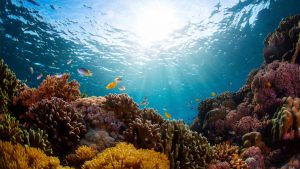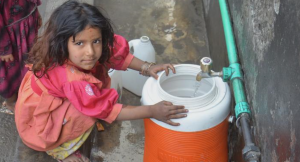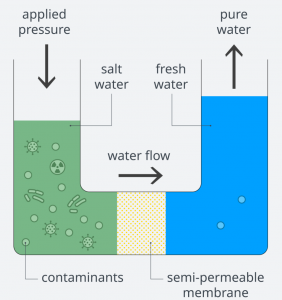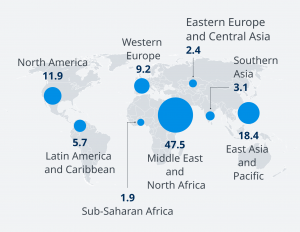Anant Mitra

Figure 59.1 – ‘Underwater scene of a coral reef and tropical fish’, Picture courtesy: Dudarev Mikhail9
There are now almost 16,000 desalination plants operating in 177 countries. While there’s no shortage of seawater, it’s important to understand and monitor the impact of the rapidly growing number of desalination plants on the environment. Desalination is the process of removing salts from water and a by-product of the process is a toxic brine which can degrade coastal and marine ecosystems unless treated.
The Challenge
1 in 3 people globally do not have access to safe drinking water meaning that some 2.2 billion people around the world do not have safely managed drinking water services.1

Figure 59.2 – A girl fills a jerrycan in Pakistan.8
Water is a basic essential for us, therefore, we have developed several kinds of water supply systems around the world. However, all of them have a common problem, they all need natural freshwater resources. The research by 2 illustrates that nearly 97% of the earth’s water is seawater while another 2% is fresh water but locked in icecaps and glaciers. The available fresh water just accounts for about 0.5% of the earth’s total water supply. A point to keep in mind, anthropogenic activities have polluted large amounts of fresh water sources. This translates to the fact that the traditional water supply systems can use much lesser than the 0.5% earlier mentioned. It is obvious that we cannot just rely on these traditional water supply systems anymore.3
The Solution at hand
In the fourth century BC, Aristotle found that when saltwater turns into vapor, salt and freshwater separate from each other. This was the first desalination theory and it has been more than 2000 years since it was discovered. Earlier theories had upheld the several advantages of desalination but in recent years the desalination techniques used have been questioned on grounds of reliability as well as cost effectiveness. With the invention of multi-stage flash process and reverse osmosis the desalination technology has advanced a lot in the last 30 years. Compared to the traditional options, the desalination technology does not need natural freshwater resources. This technology gives human beings an opportunity to tap into most of the earth’s water resource. It was a revolutionary idea that we need not rely on natural freshwater resource anymore. Due to its unique advantage, desalination has developed rapidly in the recent decades and is playing an important role in many countries now. 3

Figure 59.3 – How reverse osmosis works.8
For example, according to research by 4, in Saudi Arabia the desalination equipment produces more than 6,000,000 m3 of freshwater per day. This technology has become a reliable fresh water source for human beings. So, these technological advances in the last 30 years have driven down the cost of desalinated water significantly. The price of desalination shows a decreasing trend from 1988 to 2000. The cost of desalination decreased from 1.7$/m3 in 1988 to 0.7$/m3 in 2000. This cost is highly competitive with the traditional water supply alternatives thus it is an acceptable price for several countries now and due to the decreasing trend, it can be predicted that desalination processes will get cheaper in the future.
The decreasing cost trend is just one economic benefit of desalination. Another reason is in some situations, desalination is a cheaper water supply option. For example, China’s water resources are unevenly distributed and many places in northern China are facing the water shortage problem. So, the government decides to build a long pipeline to transfer water from the Yangtze River to an area in northern China. Research by 4 shows the main canal would be 1150 km long. From the research by 5 we already find that the cost of transport is around 0.061$/m3 per 100 km. Therefore, it means that the cost of transferring water will more than 0.7$/m3. Transportation costs are much higher than desalination, especially as desalination costs have fallen from 1.7$/m3 to 0.7 $/m3 and are still going down. Desalination also has its economic benefits and is a possible alternative to the traditional water systems.
Desalination, really?
Oceans cover 70 per cent of the planet. Oceans alone provide nourishment for over three billion people and absorb 30 per cent of carbon dioxide released into the atmosphere and 90 per cent of the heat from climate change. Increasingly, they are a source of generating freshwater for a burgeoning population in recent times.
While there’s no shortage of seawater making desalination an attractive technology, it’s important to understand and monitor the impact that these rapidly growing number of desalination plants carry on the environment. Often these aspects are overlooked as this process caters for the greater good of humans. Let’s talk about the ‘Brine’ which isn’t usually discussed when talking about desalination. Desalination is the process of removing salts from water which produces freshwater and a by-product of the process is a toxic brine which can degrade coastal and marine ecosystems unless treated.
In most desalination processes, for every litre of potable water produced, about 1.5 litres of highly saline liquid polluted with chlorine and copper are created, this liquid is the Brine. This is pumped back into the ocean; the toxic brine depletes oxygen and impacts organisms along the food chain.6
“Increased salinity and temperature can cause a decrease in the dissolved oxygen content, resulting in conditions called hypoxia,” says Manzoor Qadir, Assistant Director of the United Nations University Institute for Water, Environment and Health (UNU-INWEH).6
Impacts of hypoxia include changes in populations of marine organisms, such as large-scale mortality and behavioural responses, as well as variations of species distributions, biodiversity, physiological stress, and other sub-lethal effects (e.g. growth and reproduction). This can harm organisms living on or in the bottom of a water body and translate into observable effects throughout the food chain. In addition, the presence of certain compounds (e.g. copper, chloride) as a waste by product produced in the desalination pre-treatment process is toxic in nature to organisms in the receiving water.
The relationship between desalinization and climate change is complex. Global warming has increased droughts around the world and turned formerly verdant landscapes into near deserts. Some long held fresh water sources are simply no longer reliably available to hundreds of millions of people around the world.

Figure 59.4 – Desalination capacity by region (in percent).8
The rising populations in desert areas is resulting in intense pressure on existing fresh water supplies, thereby forcing communities to turn to desalinization as the most expedient way to satisfy their collective thirst. But the process of desalinization burns up many more fossil fuels than sourcing the equivalent amount of fresh water from freshwater bodies. As such, the very proliferation of desalinization plants around the world‚ some 16,000 already supply fresh water in 177 nations, primarily in the Middle East, North Africa and Caribbean, is both a reaction to and one of many contributors to global warming..7
Marine biologists warn that widespread desalinization would take a heavy toll on ocean biodiversity; as such facilities’ intake pipes essentially vacuum up and inadvertently kill millions of plankton, fish eggs, fish larvae and other microbial organisms that constitute the base layer of the marine food chain. According to Jeffrey Graham of the Scripps Institute of Oceanography’s Center for Marine Biotechnology and Biomedicine, the salty sludge by-product after desalinization for every gallon of freshwater produced, another gallon of doubly concentrated salt water is generated which needs to be disposed and can wreak havoc on marine ecosystems if dumped willy-nilly offshore. Graham says, the disappearance of some organisms from discharge areas may be related to the salty outflow and it’s improper disposal into the marine water bodies.
The Guardian reported in January 2020 ‘Antofagasta, situated on the edge of the Atacama Desert, relies on a vast desalination plant which provides the city with drinking water – but the waste brine is killing wildlife, say fishermen’, this is one such article amidst several other voicing the concerns of the fishermen across the globe.
Of course, as supplies of fresh water dwindle, the economic cost of desalinization‚ especially in coastal areas with easy access to ocean water‚ begins to look competitive with traditional water sourcing.
Ponder before we blunder
While desalination may seem like the future we are headed into for water accessibility, it is key to remind ourselves about how we humans have consistently depleted the Earth’s resources by overexploiting for our needs while producing tons of waste, Greenhouse gases and pollutants in return. Look around yourself, you’ll see how well we succeeded at changing the Earth’s climate and now we are spending millions to rectify our past actions.
Oceans and Seas are amongst the few natural habitats that anthropogenic activities didn’t venture deeply into. Bear in mind the contribution that these water bodies play in controlling climate change through absorbing about 30 percent of all carbon dioxide emissions.
In order to ensure that we as humans don’t have to witness another tragedy resulting from overexploitation of resources, guidelines on identifying brine disposal spots and strict regulations on brine treatment before disposal should be implemented on a global standard with every country using desalination treatment being liable to adhere to these standards. These steps need to be taken alongside technological studies on making the desalination process more environment friendly (for example using Solar power to meet the energy demands of the plants).
If desalination is the future, then let us act responsibly for ourselves and the future generations before it’s too little too late.
References:
- UNICEF, & WHO. (2019). 1 in 3 people globally do not have access to safe drinking water. https://www.who.int/news-room/detail/18-06-2019-1-in-3-people-globally-do-not-have-access-to-safe-drinking-water-unicef-who
- Khawaji, Akili D., Ibrahim K. Kutubkhanah, and Jong-Mihn Wie. “A 13.3 MGD seawater RO desalination plant for Yanbu Industrial City.” Desalination 203.1-3 (2007): 176-188.
- Essays, UK. (November 2018). Why Is Desalination Becoming So Important?. Retrieved from https://www.ukessays.com/essays/environmental-sciences/why-is-desalination-becoming-so-important-environmental-sciences-essay.php?vref=1)
- Wang, Shichang, Qing Zhou, and Zhi Wang. “Development of desalination and reverse osmosis.” MEMBRANE SCIENCE AND TECHNOLOGY-LANZHOU- 23.4 (2003): 162-165.
- Zhou, Yuan, and Richard SJ Tol. “Evaluating the costs of desalination and water transport.” Water resources research 41.3 (2005).
- UN Towards sustainable desalination, 2019, https://www.unenvironment.org/news-and-stories/story/towards-sustainable-desalination
- Fred Kuepper. “The Impacts of Relying on Desalination for Water”, 2009, https://www.scientificamerican.com/article/the-impacts-of-relying-on-desalination/)
- ‘Can we drink our oceans? Five things you need to know about desalination’ , https://www.dw.com/en/can-we-drink-our-oceans-five-things-you-need-to-know-about-desalination/a-47083938
- ‘Underwater scene of a coral reef and tropical fish’, iStock.com/DudarevMikhail, The MSC and the United Nations Sustainable Development Goals, https://www.msc.org/about-the-msc/the-mscs-sustainability-goals
Media Attributions
- underwater-coral-for-sdgs-page
- SDG1
- SDG3
- SDG2 edited